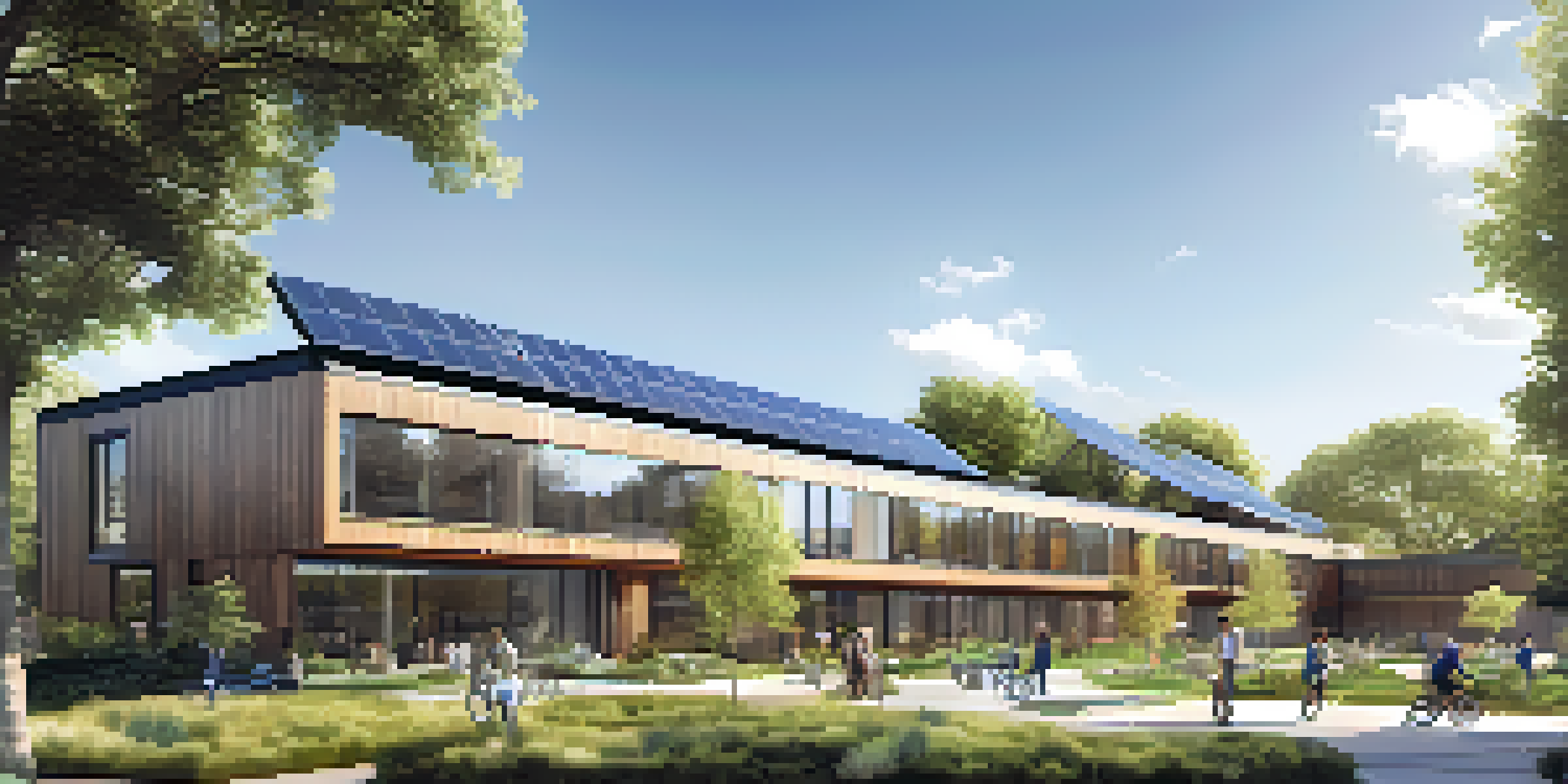The Future of Net-Zero Energy Buildings in Real Estate

Understanding Net-Zero Energy Buildings and Their Importance
Net-zero energy buildings (NZEBs) are structures that produce as much energy as they consume over a year. This balance is achieved through energy-efficient designs, renewable energy sources, and smart technologies. As the world grapples with climate change, the importance of NZEBs grows, serving as a beacon of sustainability in real estate.
Sustainability is no longer about doing less harm. It's about doing more good.
These buildings not only minimize environmental impact but also promise economic benefits. For instance, they often lead to lower utility bills and increased property values. As such, NZEBs are becoming an attractive option for both developers and buyers looking to invest in sustainable properties.
Moreover, the shift towards net-zero energy is not just a trend; it's a necessity. With international agreements pushing for carbon neutrality, the real estate sector must adapt to meet new standards and consumer expectations, making NZEBs a pivotal part of the future landscape.
Technological Innovations Driving Net-Zero Energy Buildings
The integration of technology in building design is revolutionizing how we approach net-zero energy. Advanced building materials, energy-efficient HVAC systems, and smart home technologies all contribute to reducing energy consumption. For example, smart thermostats can adjust heating and cooling in real-time, optimizing energy usage.

Additionally, renewable energy sources like solar panels and wind turbines are becoming more accessible and efficient. Many NZEBs are now equipped with these technologies, allowing them to generate their own power and even sell excess energy back to the grid. This innovation not only supports sustainability but also enhances the property’s value.
NZEBs Balance Energy Use and Production
Net-zero energy buildings produce as much energy as they consume, making them essential for sustainable real estate.
As technologies continue to evolve, we can expect even greater strides in the net-zero energy movement. From battery storage solutions to energy management software, these advancements will empower building owners and occupants to maintain optimal energy efficiency.
Policy Changes and Government Initiatives Supporting NZEBs
Government policies play a crucial role in promoting net-zero energy buildings. Many countries are introducing regulations and incentives to encourage developers to adopt sustainable practices. For example, tax credits for renewable energy installations can significantly offset upfront costs for builders.
The greatest threat to our planet is the belief that someone else will save it.
In addition to financial incentives, numerous governments are setting ambitious targets for energy efficiency in new construction. These mandates often require a certain percentage of energy to come from renewable sources, pushing the industry toward net-zero standards. This regulatory environment is shaping the future of real estate development.
Furthermore, international frameworks, like the Paris Agreement, are fostering collaboration among nations to share best practices and technologies. As countries strive to meet their climate goals, NZEBs will increasingly be at the forefront of real estate strategies.
The Role of Architects and Designers in NZEB Development
Architects and designers are essential players in the net-zero energy building movement. Their creative vision and expertise in sustainable design can significantly impact a building's energy efficiency. For instance, optimizing natural light through strategic window placement can reduce the need for artificial lighting.
Incorporating passive design principles is another way architects contribute to NZEBs. Techniques such as proper insulation, ventilation, and thermal mass can help maintain comfortable indoor temperatures without relying heavily on heating or cooling systems. This thoughtful approach reduces energy consumption right from the blueprint stage.
Tech Innovations Drive Sustainability
Advancements like smart technologies and renewable energy sources are key to enhancing energy efficiency in net-zero energy buildings.
As the demand for NZEBs grows, architects are increasingly focusing on innovative design solutions that marry aesthetics with sustainability. The challenge lies in creating spaces that not only meet energy goals but also resonate with occupants, making them feel at home.
Challenges Facing the Adoption of Net-Zero Energy Buildings
Despite the clear benefits of net-zero energy buildings, several challenges hinder widespread adoption. One major obstacle is the higher initial construction costs associated with advanced materials and technologies. Many developers are hesitant to invest in these upfront expenses despite the long-term savings.
Moreover, the lack of awareness and understanding of NZEBs among consumers can slow down market demand. Potential buyers may not fully grasp the advantages of living in a net-zero energy home, leading to reluctance in making informed purchasing decisions. Education and outreach are critical to overcoming this knowledge gap.
Lastly, the existing infrastructure in many cities may not support the implementation of NZEBs. From outdated electrical grids to zoning laws that do not accommodate innovative designs, these barriers must be addressed to pave the way for a more sustainable future in real estate.
Market Trends Indicating Growth in NZEB Real Estate
The real estate market is witnessing a notable shift toward sustainability, with net-zero energy buildings leading the charge. Reports indicate that properties with energy-efficient features are gaining popularity among buyers, who prioritize eco-friendliness. This trend is particularly evident among younger generations who are more conscious of environmental issues.
Additionally, as energy prices fluctuate, the appeal of NZEBs becomes even more pronounced. Homebuyers are increasingly attracted to properties that promise lower energy costs and greater resilience against price volatility. This economic advantage is driving more developers to incorporate net-zero energy principles into their projects.
Government Support for NZEB Adoption
Policies and incentives from governments are crucial in promoting the development and implementation of net-zero energy buildings.
Furthermore, the growing availability of financing options specifically tailored for sustainable construction is encouraging developers to invest in NZEBs. As institutional investors and banks recognize the long-term viability of these buildings, we can expect a surge in projects that meet net-zero energy standards.
The Impact of NZEBs on Community and Urban Planning
Net-zero energy buildings have the potential to transform communities and urban landscapes. By prioritizing energy efficiency and sustainability, these buildings contribute to healthier environments, reducing pollution and greenhouse gas emissions. In turn, this can enhance the overall quality of life for residents.
Moreover, the development of NZEBs often encourages a sense of community. Many projects incorporate shared spaces and resources that foster social interactions among residents. This communal approach not only strengthens neighborhood ties but also promotes collective responsibility for sustainability.

Urban planners are also recognizing the importance of integrating NZEBs into broader city designs. By creating zones dedicated to sustainable living, cities can attract eco-conscious residents and businesses, driving economic growth while prioritizing environmental stewardship.